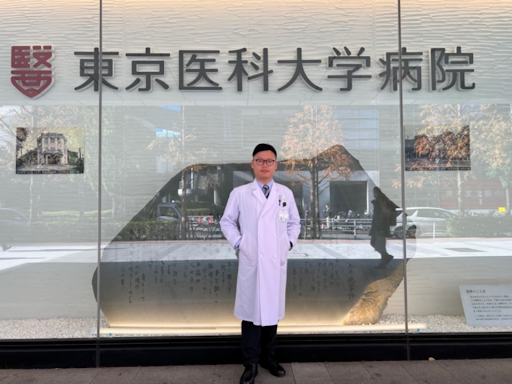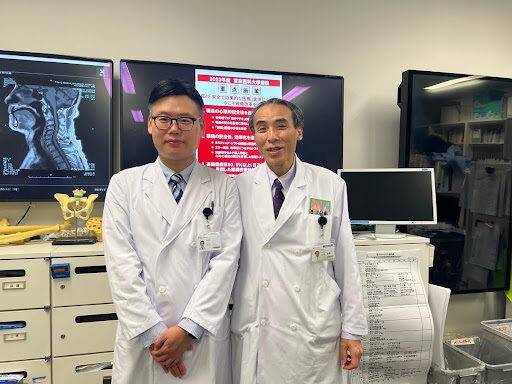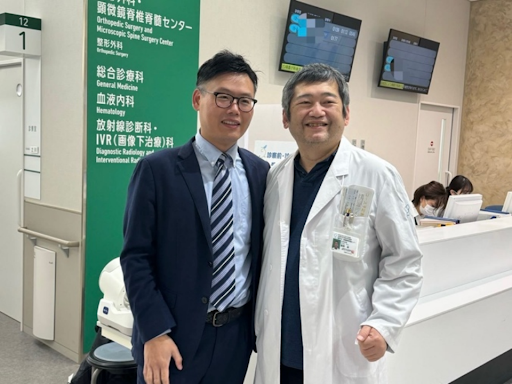Time flies swiftly, and my three-month overseas internship in Japan is nearing its end. During these three months, in addition to gaining professional knowledge, I have also forged valuable friendships, especially with the Japanese faculty. I am Dr. Zhang Li from the Neurosurgery Department of Zhangjiagang First People’s Hospital. Selected in 2019 for the “Jiangsu-Japan International Cooperation Center Project” under the 2020 Jiangsu Provincial Health International (Regional) Exchange Support Plan, the program was delayed due to the pandemic. This year, I joined the newly selected 2023 team members for our study in Japan. Reflecting on these three months, I am left with many wonderful and unforgettable memories.
Assigned to the Spine Division of the Orthopedic Surgery Department at Tokyo Medical University Hospital for my training, I found myself in the bustling Shinjuku district of Tokyo. The hospital, affiliated with Tokyo Medical University (established in 1906 as a prestigious century-old medical school in Japan), is a comprehensive facility integrating medical care, teaching, research, prevention, and health management. Recognized since December 1993 by the Japanese government as a “Special Skill Hospital” for its high-quality medical services, advanced medical technology, and superior training, the hospital has a rich 90-year history since its opening in 1931, marked by significant achievements in patient care and medical innovation. The hospital, modest in size and open like many Japanese universities, stands as a super-modern structure, surpassing any I have seen in terms of cleanliness, organization, and efficiency. The new building, designed in 2019 by a renowned Japanese architect, embraces a grey and white color scheme. Unlike many hospitals in my country that are rebuilt off-site, Tokyo Medical University Hospital was reconstructed on its original site, with a multi-story car park erected on the old hospital’s footprint. The facility is divided into three main buildings: Outpatient, Inpatient, and Research, interconnected by sky bridges.

Image 1: At the entrance of Tokyo Medical University Hospital’s Outpatient Department.
The Orthopedic Surgery Department is segmented into four divisions: Joint and Sports Medicine, Trauma、Upper Limb and Tumor, Spine, and Basic Research. These divisions are known as ‘groups’ in Japan, and I was a member of the Spine group, treating exclusively spinal disorders. The department is led by Professor Kengo Yamamoto. Professor Yamamoto is an expert in joint and reconstructive surgery, studied at Loma Linda University in the United States at the end of the last century. He places great emphasis on the training of young doctors. At Tokyo Medical University Hospital’s Department of Orthopedic Surgery, young doctors receive comprehensive and systematic education to ensure they gain the necessary knowledge and skills during their professional training. Additionally, Professor Yamamoto encourages young doctors to delve deeply into their areas of interest and become experts in those fields. The Spine group is under the stewardship of Associate Professors Kenji Endo and Takato Aihara . Professor Endo, at 62, maintains a youthful appearance, seeming only just over 50. He has been focusing on Drooping Head Syndrome (DHS), a disease I hadn’t encountered before coming to Japan. Recognizing my intrigue, he kindly elucidated DHS in English and presented his written works on DHS as gifts. Professor Aihara, also 62, is an expert in endoscopic MED and anterior thoracolumbar surgeries, having pioneered these procedures for various thoracolumbar issues, including infections, fractures, and deformities, well before the introduction of XLIF and OLIF. Given the prevalence of multi-site practice in Japanese hospitals, Professor Aihara, besides his duties at Tokyo Medical University Hospital, also serves at other hospitals. Hence, I mostly encountered him on designated surgery days. Professor Endo, on the other hand, devotes one day a week to visiting other hospital. Both professors rarely lead surgeries at Tokyo Medical University Hospital, focusing more on mentoring young surgeons. Primary responsibility for spine surgeries falls to Drs. Hirosuke Nishimura, Takamitsu Konishi, Taro Uehara, and Hiroto Kobayashi.

Image 2: With Professor Kengo Yamamoto, Director of hospital and Chief of Orthopedic Surgery at Tokyo Medical University Hospital, in the Orthopedic Department.

Image 3: With Associate Professor Kenji Endo of the Orthopedic Spine Division at Tokyo Medical University Hospital, in the Orthopedic Department.
My initial visit to the Central Surgery Department at Tokyo Medical University Hospital left a lasting impression. The operating area, bathed in a soft milky white, featured spacious corridors and 20 well-equipped operating rooms. Each room boasts 5 to 6 4K high-definition monitors, facilitating the retrieval of surgical data, real-time recording of surgeries, and vital sign monitoring, benefitting surgeons, anesthetists, and circulating nurses alike. Operating rooms 16 and 17 are dedicated to orthopedic surgeries, offering ample space and equipped with the MAKO surgical robot and the second-generation O-arm navigation system.

Figure 4: The use of O-arm navigation during spinal surgery, performed by DRs.Hirosuke Nishimura and Taro Uehara,at Tokyo Medical University Hospital’s Central Surgery Room No. 17.
In addition to surgeries, I also joined Professors Endo and Aihara in outpatient clinics, where each doctor is assisted by a nurse. Professor Endo often runs special VIP clinics, primarily for patients with Drooping Head Syndrome (DHS). Professor Aihara’s clinic, on the other hand, sees patients with various spinal diseases. Both professors were incredibly kind and patient, often demonstrating rehabilitation exercises themselves. Patients and their families showed great respect and gratitude towards the medical staff, actively cooperating with the treatment plans and diagnoses proposed by the doctors. Since the outpatient communication was solely in Japanese, both professors would explain the patients’ main complaints and their medical opinions to me in English after the patients had left. Patients visiting the university hospital were required to have a referral letter, and the outpatient volume was strictly controlled to ensure quality care, with only a dozen or so patients seen in a half-day. The majority of these patients were returning for follow-up visits. Besides prescribing medication and guiding exercises, doctors would schedule the next visit for each patient and arrange any necessary X-ray or MRI scans, with the assistance of the nurse who organized all relevant reports and imaging for the patient.
I participated in morning meetings of the orthopedic and spine teams every working day. Except for Tuesdays, the spine team’s morning meetings started at 7 AM, discussing the status of surgical patients and analyzing upcoming surgeries, including reviewing imaging and surgical plans. The professors would point out any shortcomings in previous surgeries and provide technical advice. Fridays were reserved for literature review, and rotating doctors were required to present on a topic before completing their rotation. The departmental handover meeting, led by Dr. Ishida, began at 8 AM daily, where on-call doctors reported, and the team discussed patients who had undergone surgery the previous day and those scheduled for upcoming surgeries. Notifications of meetings and administrative matters were also announced at this time. Doctors who attended external meetings or exchanges were required to present a report in the form of a PowerPoint presentation during the weekly Wednesday general meeting. Japanese doctors are highly focused at work, rarely using personal phones and relying instead on PHS phones for communication. When Professor Endo was not in surgery or clinic, he dedicated his time to researching literature, writing papers, and editing manuscripts from junior doctors.
Beyond work, Professor Endo and the spine team faculty took great care of me. They not only hosted a welcome dinner for me but also frequently invited me to team-building events and were always concerned about my well-being, offering advice on life and transportation in Tokyo. On surgery days, Professor Endo would have his secretary arrange lunches for us, so we didn’t have to worry about meals even if the cafeteria was closed post-surgery. As the year-end approached, Professor Yamamoto graciously invited me to the orthopedic department’s year-end party, an honor I greatly appreciated.
During my tenure at Tokyo Medical University Hospital, I had the opportunity to meet Dr. Yasushi Fujiwara from Hiroshima City North Medical Center Asa Citizens Hospital, an adjunct professor at Tokyo Medical University. He visits monthly for surgeries. In mid-November, Professor Fujiwara brought Dr. Farid from Indonesia, who was undergoing training in microscope-assisted spinal surgery under his guidance at Asa Citizens Hospital. On December 6th, thanks to Professor Endo’s arrangement, I had the privilege of joining Drs. Taro Uehara, and Hiroto Kobayashi for a three-day observational visit to Hiroshima Asa Citizens Hospital to witness Professor Fujiwara’s team performing microscope-assisted spinal cord surgery. Professor Fujiwara demonstrated a revision surgery for syringomyelia, using not only a microscope but also a flexible endoscope to inspect for adhesions under the hard spinal membrane. This was my first experience seeing an endoscope used in such a procedure. Drs. Uehara and Kobayashi, both graduates of Hiroshima University, took me to visit Hiroshima Castle and the Hiroshima Peace Memorial Park during our stay. In Hiroshima, we also met Dr. Wataru Narita from Kyoto Kameoka Municipal Hospital, who, as the president of the 16th Minimally Invasive Spine Treatment (MIST) Conference in 2025, invited us to attend the conference in Kyoto.

Figure 5: A photo with Associate Professor Yasushi Fujiwara of Tokyo Medical University Hospital, taken at the Outpatient Clinic of Hiroshima City North Medical Center Asa Citizens Hospital.
My daily interactions at work allowed me to deeply appreciate the harmonious relationships within the hospital and department, the strong academic atmosphere, meticulous work attitude, advanced medical technology, comprehensive information systems, and the overall excellent medical environment.


